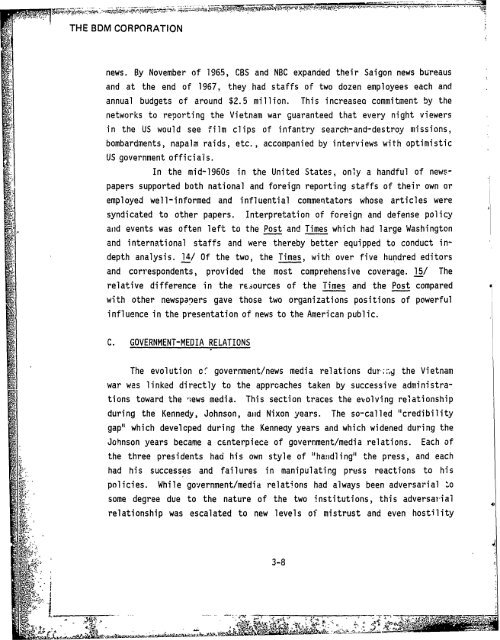policy - The Black Vault
policy - The Black Vault
policy - The Black Vault
Create successful ePaper yourself
Turn your PDF publications into a flip-book with our unique Google optimized e-Paper software.
THE BDM CORPORATION<br />
news. By November of 1965, CBS and NBC expanded their Saigon news bureaus<br />
and at the end of 1967, they had staffs of two dozen employees each and<br />
annual budgets of around $2.5 million. This increasea commitment by the<br />
networks to reporting the Vietnam war guaranteed that every night viewers<br />
in the US<br />
bombardments,<br />
would see film clips of infantry search-and-destroy missions,<br />
US government officials.<br />
napalm raids, etc., accompanied by interviews with optimistic<br />
In the mid-1960s in the United States, only a handful of newspapers<br />
supported both national and foreign reporting staffs of their own or<br />
employed well-informed and influential commentators whose articles were<br />
syndicated to other papers.<br />
Interpretation of foreign and defense <strong>policy</strong><br />
atid events was often left to the Post and Times which had large Washington<br />
and international staffs and were thereby better equipped to conduct indepth<br />
analysis. 14/ Of the two, the Times, with over five hundred editors<br />
and correspondents, provided the most comprehensive coverage. 15/ <strong>The</strong><br />
relative difference in the reiources of the Times and the Post compared<br />
with other newspap~ers<br />
gave those two organizations positions of powerful<br />
influence in the presentation of news to the American public.<br />
C. GOVERNMENT-MEDIA RELATIONS<br />
<strong>The</strong> evolution c• government/news media relations dur.;:-,g the Vietnam<br />
war was linked directly to the approaches taken by successive administrations<br />
toward the sews media.<br />
This section traces the evolving relationship<br />
during the Kennedy, Johnson, and Nixon years. <strong>The</strong> so-called "credibility<br />
gap" which developed during the Kenneay years and which widened during the<br />
Johnson years became a centerpiece of government/media relations. Each of<br />
the three presidents had his own style of "handling" the press, and each<br />
had his successes and failures in manipulating press reactions to his<br />
policies.<br />
While government/media relations had always been adversarial 'o<br />
some degree due to the nature of the two institutions, this adversarial<br />
relationship was<br />
escalated to new levels of mistrust and even hostility<br />
3-8<br />
a
















